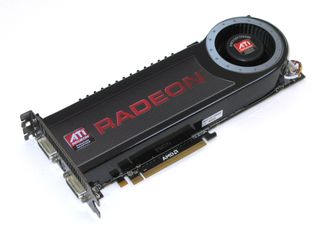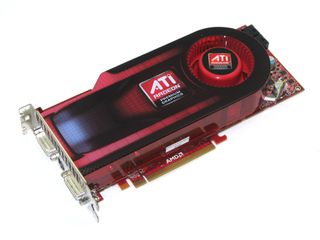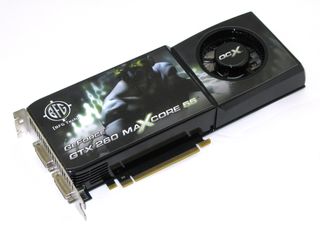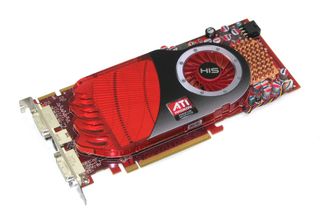Part 2: Building A Balanced Gaming PC
Graphics Cards

If you have any hope of playing the latest games in their full glory (by which we mean max'ed out details) and at high native LCD resolutions, we can’t overstate how important it is to have a powerful graphics card in your system. For our purposes here, we chose three cards from ATI and three cards from Nvidia, covering (at the time) a snapshot of the available gaming solutions priced $100 and up.
Naturally, a series of this magnitude takes weeks to plan for and test for; since we began, ATI has launched its Radeon HD 5000-series DirectX 11 boards. Thus, data for those cards wasn't available for the previous segment, nor will it be in this one. However, we're hoping to incorporate them into Parts 3 and 4.
Nevertheless, it's fairly easy to draw some parallels to our choices here, since ATI essentially doubled the resources on its previous single-GPU flagship. When you see a Radeon HD 4870 X2, imagine a Radeon HD 5870 there. The Radeon HD 4890 will generally be faster than the Radeon HD 5770. And the Radeon HD 5750 often looks a lot like the older Radeon HD 4770, if not a bit faster when you apply anti-aliasing.

BFG GeForce GTX 295
Representing the flagship of Nvidia’s GTX 200-series is the BFG GeForce GTX 295. Unlike the original GTX 295s, built on two PCBs, this newer revision features two GT200b GPUs on a single PCB.
Sporting a total of 1,792MB GDDR3 (896MB per GPU), two 448-bit memory interfaces, a 576 MHz core clock rate, a 1,242 MHz shader clock, and a 999 MHz memory clock, each GPU has the general specifications of Nvidia's GeForce GTX 260. However, the GPUs themselves boast a full 240 stream processing cores, like the GeForce GTX 285, GeForce GTX 280, and GeForce GTX 275.

ATI Radeon HD 4870 X2
Stay on the Cutting Edge
Join the experts who read Tom's Hardware for the inside track on enthusiast PC tech news — and have for over 25 years. We'll send breaking news and in-depth reviews of CPUs, GPUs, AI, maker hardware and more straight to your inbox.
The flagship of ATI’s Radeon HD 4800-series is still the Radeon HD 4870 X2, a card consisting of two Radeon HD 4870 GPUs. Each processor has its own dedicated 1GB GDDR5 (2GB total) frame buffer. The individual GPU specs are identical to a single-chip Radeon HD 4870, including 800 stream processors, 40 texture units, 16 ROPs (Raster Operation Units), a 256-bit memory bus, 750 MHz GPU, and 900 MHz memory frequency.

BFG GeForce GTX 285 OCFU
This BFG GeForce GTX 285 OCFU represents the most powerful single-GPU card available for our first round of testing. Its features include 240 shader processors, a 712 MHz core clock rate, a 1,620 MHz shader clock rate, 1GB of GDDR3 memory running at 1,332 MHz (2,664 MHz effective), and a 512-bit memory interface. These are extremely high (albeit overclocked) clock rates right out of the box, backed by BFG’s lifetime warranty.
For Part 1 and Part 2 testing, we down-clock this board to reference GeForce GTX 285 speeds of 648 MHz (core), 1,476 MHz (shader), and 1,242 MHz (memory).

ATI Radeon HD 4890
Representing ATI’s top single-GPU card from the 4800-series generation, the Radeon HD 4890 has the same vital GPU specifications listed above for the Radeon HD 4870 X2, like 1GB of GDDR5 memory, 800 shader processors, 40 texture units, 16 ROPs, and a 256-bit memory bus. However, the RV790 graphics processor made it possible for ATI to serve up higher clock rates (up to 850 MHz on the core and 975 MHz memory).

BFG GeForce GTX 260 OCX Max Core 55
The BFG GeForce GTX 260 OCX Max Core 55 combines 216 shader processors, 896MB of GDDR3 memory, BFG’s highest factory overclock on a GeForce GTX 260 of 655 MHz core, 1,404 shader, and 1,125 MHz on the memory clock (2,250 MHz effective). Of course, it's also covered by BFG’s lifetime warranty.
We again down-clock this board to reference speeds of 576 MHz core, 1,242 MHz shader, and 999 MHz memory frequencies for initial testing in Part 1 and 2.

HIS Radeon HD 4850 512MB
The HIS Radeon HD 4850 has the same 800 ALUs, 40 texture units, and 16 ROPs as its bigger brothers, but it also has a lower GPU clock of 625MHz and 512MB of GDDR3 running at 993 MHz (1,986 MHz effective).
As a reminder: all testing for this first part was finished, but we couldn’t kick this series off prior to ATI’s Radeon HD 5800-series launch. To see how these new cards stack up to the ones used today, be sure to check out our launch reviews here and here.
Special thanks to ATI and Nvidia for arranging the graphics hardware needed to make this entire series possible.
-
What effect does having a motherboard that unlocks the 4th core on the X2 and X3 have? In power consumption and overall performance? I'm not asking a redo of all the data, just asking for speculation by someone more knowledgeable, if I can get it.Reply
-
Readers, don't use this as your only source of info before buying a PC. The writer left out the Intel i5-750 (which has a price range around $189-209, and outperforms all of those CPUs EXCEPT the i7.) Not only that, but LGA1156 motherboards are typically cheaper than the LGA1336 mother boards. Sure, the i7 has hyper threading, and triple channel memory support, but you're gaming here, not running high end video and 3D programs that would actually make great use of hyper threading. The only benefit I can see, is if you have the extra cash to throw around and you plan on running the applications. I guess a second benefit would be expandability, since you won't be able to upgrade the 1156 chips to Intel's next line of processors, the i9. The i5 can really over clock like a beast with the right motherboard, too.Reply
The writer also left out a great GPU: the Radeon 4870 1GB. Single GPU card, almost perfect for anybody considering running today's games at 22" 1650x1080. Of course, you'd want the 4890 for bigger than that, but still, most of these cards (especially the nVidia ones) are not quite price matched with the performance. A good 4870 can run you $170, and a great 4890 can run you $199. The nVidia "equivalents" (GTX 275, 285, and 260) all run about $260+.
I'm not sure why these two great products were left out (i5 and 4870,) but if there is a good reason, disregard what I said, but honestly, I don't see the good this article is doing without at least including them. -
dragonsprayer The secret to building a balanced gaming by pc, by WarpedSystems.Reply
First, i have been building overclocked only gaming pc's since 2003 with zero failures and 3 year cpu warranty.
#1 cheap cpu - 3.0c northwood - research that far back! CPU = 920 or 750 clocked to 3.8ghz or up too 4.2ghz
#1.5 cpu cooling: in 2004 we used thermalright xp-90, while we still use the thermal right true, we perfer the noctua - research and use the best coolers.
rule 1 of air cooling: dual fans! seal the fans - see photos!
#2 raid, we run dual raid with short stroking - we have been short storking since 2004. Your hard drive arm should move as little as possible a 4 x 1000TB set is 1000GB of raid0 for the c drive. the remaing 3TB is raid 10.
ssd: we run raid5 on hard drive and single ssd as the c drive, the raid 5 is data drive/game drive. This could be a raid0 or raid10.
Video card, you put all your money in the video card! A $2000 computer can have a GTX 295 use the i5 750. A $3000 air cooled system will have 2 video cards.
Power supply = .6 x true max power. this is usually 500 watts to 600 watts of max power. A 750, 850 or 1000 is best. NEVER GO LESS THEN 40% OF AVERAGE! 60% rule allows for a video card upgrade.
Case ...fans, fans and more fans. Anetec 1200 can not be beat for air cooling. All cases are copies of the antec 900. There are many good cases but you want 1 120mm in, 120mm out rear and 1 120 mm blowing on the video card. or 2 80's or bigger
antec 1200 has 2 rear 120mm and 2 front - we pull one section on both the 900 and 1200 and hide wires in the lower cubbie. That means we move the bottom cage up 1 slot, we remove 1 3 slot cage.
check THG links: http://images.google.com/images?hl=en&rlz=1T4GGIH_enUS236US236&um=1&q=warpedsystems+thg&sa=N&start=0&ndsp=18
finally bios tuning - memory and bus speed are critical, too high is bad!!! Too high is bad! fsb 1600 or 400x4 has been the sweet spot for years. Whether your running a G0 6600 at 3.6GHz 1600fsb or QX9600 at 1l multiplier at 4.4ghz 1600fsb works! Above that you run into many many issues. At fsb 1600 ram timmigs are ddr2 = 2.0-2.1v 4-3-4-10, 4-4-4-12, etc with core 2 ddr3 at 1.91v you have 7-7-7 with the i7/i5 you run 1.64v at 8-8-8-20 or 8-7-8-20. you find true 100% stablity with the correct timings and fsb and you do not get odd phase bus speeds.
yes, you can tweek the system to 1800mhz but do the tests and you find in most cases you spent more money to get little performance gains and lost stability -- 97-100% stablity. 100% = zero crashes - never!
temps, video card temps are key. Manually set fan speeds to stay under 75c with 70c the best. Stock temps and high cards run 80-85c even with good systems. You can use really good cooling to reduce that with antec 1200 etc. A 120mm fan does not fit an i7 mobo - we use 92mm fans in the door and hot glue it.
Conclusion, overclock your cpu, remember the difference between an i7 920 and 975 may only be factory setting and both run the same speed! Buy the best video card, use the best cooling case and cpu cooler. If your not using a SSD ....RAID RAID RAID! RUN RAID! IT IS EASY!
good luck, you find you get alienware level performance just as i did in 2003 after a few weeks of bios tuning! -
1898 BlackDays:Reply
Please, if you want to criticise something make sure you've understood it (read in this case) thoroughly. Otherwise you'll look like an idiot.
Anyway, this series is made out of win!
Thank you. -
knightmike This article truly is revolutionary. I have been waiting for an article like this since I began building my own PCs ten years ago. This article coupled with your CPU and GPU hierarchy chart will go a long way towards eliminating CPU/GPU bottlenecks. This article truly is the first of its kind and I hope to see it at least twice a year if not four times a year. Thank you.Reply -
knightmike In your conclusion, you state that a $100 CPU does a far better job than a $100 GPU when it comes to maxing out a low resolution like 1280x1024. Can you elaborate?Reply -
amnotanoobie Hooray! Now this is a good reference on the forums when people ask for bottlenecksReply -
scrumworks How can this take weeks to plan? Perhaps if one works 15mins a day.Reply
Good to see vanilla HD4890 puts up a serious fight for GTX 285. Not that it gets any credit for that.
You should stop using Vista. It's dead already.
Most Popular

